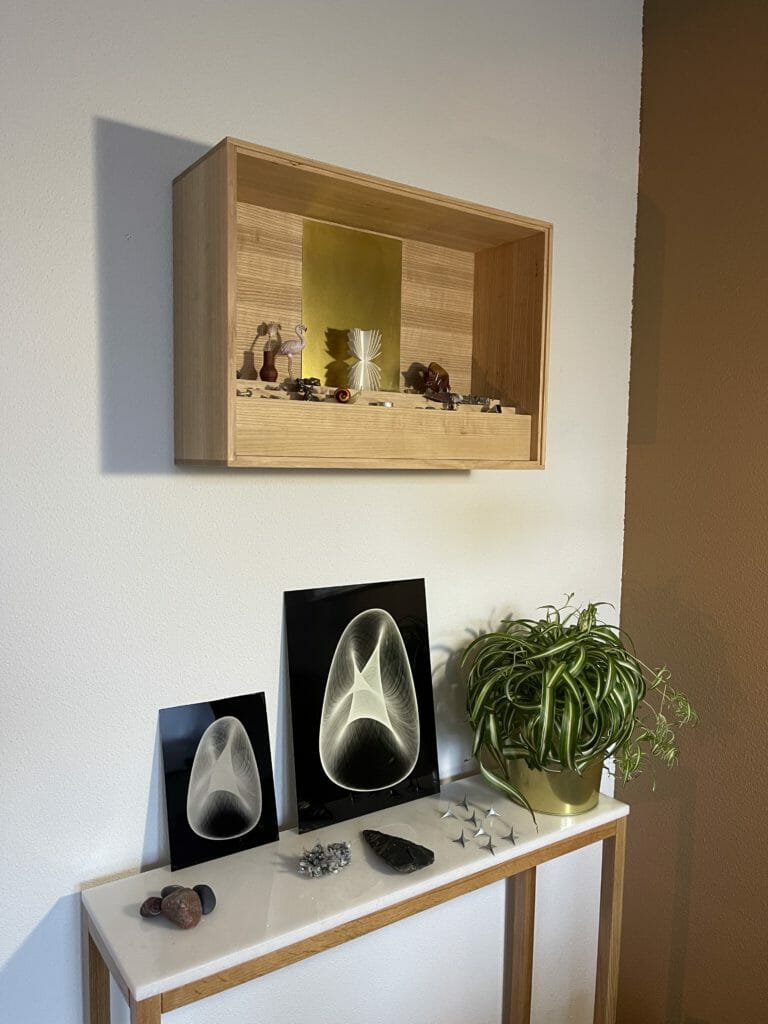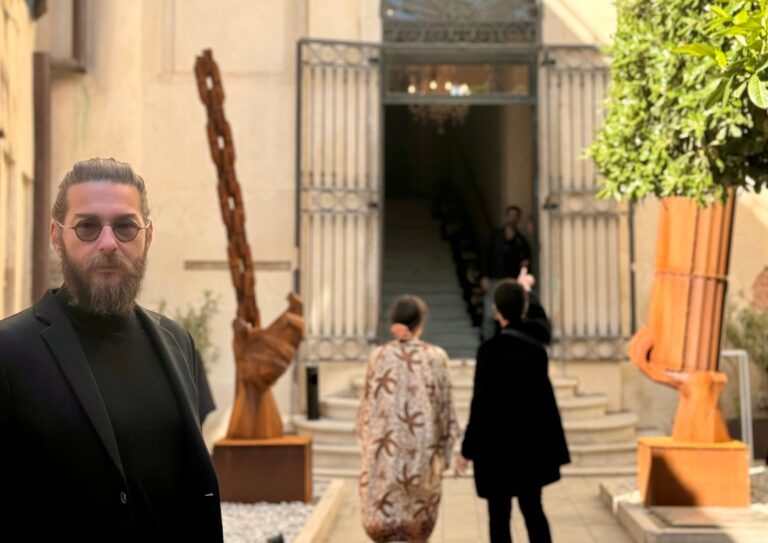
Common Body: Magdalena & Bogdan Pelmuș
Arsmonitor, Bucharest, RO
Ralf Jacobs, born in 1985 in Waalre, the Netherlands, residing and working in Eindhoven, is a contemporary artist with an educational and professional background in optics. Inspired by art, art history, science, and technology, Jacobs’s multidisciplinary practice does not encompass the usual suspects regarding artistic media and disciplines. Instead, the Dutch artist implements a broad spectrum of old and new techniques, from 19th-century cyanotypes to software-guided laser projections, into his creative process.


If we had to categorize the artistic activities of Ralf Jacobs into traditional art forms, we would end up with photography, drawing, and printmaking. For instance, with his Light Flukes, Jacobs acts as an experimental photographer by implementing strategies and technology closely related to his profession as an optical engineer.
By manner of refractography in which a laser of red, green, and blue light travels through a transparent object, analogously, the artist captures patterns of color reminiscent of cosmic phenomena—a first exhibit of the artist’s desire for the otherworldly.
Up next, we enter the realms of contemporary drawing—however, once again, we must add the word ‘experimental’ in front of the art form. Ralf Jacobs’s pen-on-paper drawings are effectuated with a device called the Harmonograph, a 19th-century mechanical apparatus using rods, weights, and swinging pendulums to create geometric images.
We encounter a similar aesthetic and pattern as with the Light Flukes mentioned above, marked by a mathematical harmony and fundamental beauty using science and technology.
But the Dutch artist does not rely on the gimmick of a 19th-century mechanical device. He uses software to emulate these mathematical motions, creating digital versions before capturing the pattern on paper. This brings us to our third medium; experimental printmaking.
Arguably the most versatile and in-demand segment of the emerging artist’s practice is the cyanotypes on paper. The cyanotype is a 19th-century printing process that creates cyan-blue prints—better known as blueprints. Using a laser tracing harmonographic images onto chemically-treated and light-sensitive paper, Jacobs evokes his recurring mathematical patterns by combining contemporary laser technology with 19th-century printing technology.
The movement of the laser is registered on a two-dimensional surface, giving form to not only mathematics but also the passing of time, resulting in a unique parallel questioning time and technology by combing obsolete practices with contemporary processes. Even more, the cyanotype enables the artist to combine harmonographic structures into photographic images—luring the otherworldly into our everyday environment, creating an unsettling tension between both visual manifestations.[1][2]

Considering Ralf Jacobs’s knowledge of science and technology, an arguably unexpected interest of the Dutch artist is the divine power of relics. He created an altar in his living room where he displays objects as relics. Born and raised in Western Europe, the artist’s understanding of what defines a relic is strongly influenced by Christianity. Nevertheless, relics as objects of devotion and desire—as in the eponymous essay by Cynthia Hahn—go beyond Christianity and even play a role in a secular world.
Cynthia Hahn: “(…) a relic is not always a natural object, and the reliquary is not always manmade. Although relics are persistently material—both by definition (from the Latin reliquiae, or “remains”) as well as in our most basic understanding—the existence and importance of relics have far more to do with operations of memory and selection than with any intrinsic worth of material things.”[3]
The idea of how an object as a container can carry a divine power intrigues Ralf Jacobs intensely, both from a psychological perspective and from an anthropological one. One could argue that any notion of divinity contradicts the universal scientific principles in Jacobs’s practice. However, the long-standing tradition of art with science and art with religion provides the ideal setting to discover the potential analogies and possibilities regarding the divine power of relics and contemporary art.

Manmade relics are closely connected to art. Think of the ancient Venus figurines functioning as relics or art objects that have been in contact with a Saint or martyr. And the influence seems to travel both ways, with our tradition, history, and behavior toward relics, influencing our perception and valuation of art objects—think of the Western obsession with originality, authenticity, and the artist’s signature. Relics are objects with an imbued value, as is art.
From this point of view, Ralf Jacobs is occupied with finding this imbued value in objects in a technological world—before putting those objects to the test on his altar. By doing so, the Dutch artist finds the divine—the wonderful or otherworldly—by analyzing the world through a scientific lens. Instead of a demystification of the world through science and technology, the opposite seems to be true. The aforementioned “operations of memory and selection” from Cynthia Hahn’s essay shift from religion to science, but without losing its divine dimension.
Ralf Jacobs: “Mathematics describes nature in the most fundamental way and yields beautiful shapes and concepts for divination.”

For instance, if divine power results from different modalities of the object—meaning its material qualities—in the eyes of Jacobs, a great candidate for material to remind us of a godly power could be Tungsten, a rigid material with the highest melting point and density comparable to Uranium and Gold. Or, in mathematics, the simple beauty of a parabola, where all parallel rays end up in the exact center—a parallel to an omnipresent Pantheism.
Or what about something much more elusive; light—another modality with a ubiquitous connection to the divine, especially in art history? Moreover, reflection, refraction, or diffraction of visible light. Glass, crystals, and objects with a microstructure near the wavelength of visible light, ~0.5µm, harness and interact magically. From the enormous electromagnetic spectrum, life chose a very small band to be encoded for sensory reception via the eyes. A specific band that suggests the artist of divine intervention with science.
Art objects have a very similar nature in comparison to relics when it comes to transcending their material qualities and obtaining an imbued value due to their presence or the touch of their illustrious creator. That’s why the attribution of a very rudimentary sketch to Da Vinci can suddenly multiply its market value but will also make the aura of the piece of paper bulge magically.
And the same applies to Modern and Contemporary Art. Think of Kazimir Malevich, who mounted his Black Square in the corner of the room. A designated place for icons of Orthodox Christianity, drawing a parallel between art and sacred objects—celebrating the supremacy of pure artistic feeling above the visual depiction of things, hence the terminology of the movement of Suprematism.
By doing so, Ralf Jacobs transforms and uses science-based art as contemporary relics. They become vehicular mediums to contain a divine power or presence, captured and preserved through technology and science. Whereas the general trend in contemporary epistemology argues science negates and demystifies the wonders of the world, making God and religion superfluous in the wider discourse initiated by Friedrich Nietzsche with his famous “Gott ist Tot”—“God is dead”—in which the enlightenment and scientific progress eliminates the possibility of a godly existence, with the divine being kicked out of the front door, Ralf Jacobs uses art and science to reenter divinity via the backdoor.
Because if we put aside our scientific and technological knowledge and simply experience the wondrous possibilities, they become pure magic. Jacobs draws with light and mathematics using a laser and software to control the shapes it creates. Mathematics dictates what kind of shapes can be drawn, and the chemical reaction of the light in the cyanotype process applied on paper can easily be regarded as sorcery by someone that doesn’t know the state-of-the-art technology of the world we live in.
As a result, the artwork becomes a testimony, a witness, or a relic of divine interventions or phenomena. It captures the natural beauty of our world’s scientific principles and mathematic structures with an otherworldly dimension.
Discover more on Ralf Jacobs’s website.
Notes:
[1] Nanne op ‘t Ende, “About” at https://ralfjacobs.net/about/ consulted December 21, 2022.
[2] “Ralf Jacobs — Experimental Photographer” (video) at https://youtu.be/MU2xarJ-fuE consulted December 21, 2022.
[3] Cynthia Hahn, Objects of Devotion and Desire: Medieval Relic to Contemporary Art. Hunter College of the City University: 2011.
Last Updated on April 19, 2024

Arsmonitor, Bucharest, RO

Palazzo Mora, Venice, IT